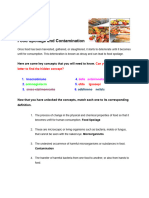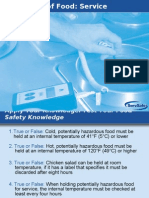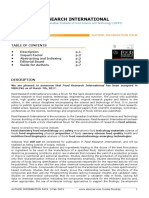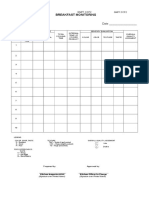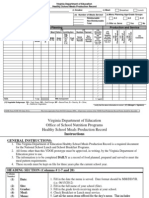Food Protection Course Lesson 3
Food Protection Course Lesson 3
Uploaded by
dbzidaneCopyright:
Available Formats
Food Protection Course Lesson 3
Food Protection Course Lesson 3
Uploaded by
dbzidaneOriginal Description:
Original Title
Copyright
Available Formats
Share this document
Did you find this document useful?
Is this content inappropriate?
Copyright:
Available Formats
Food Protection Course Lesson 3
Food Protection Course Lesson 3
Uploaded by
dbzidaneCopyright:
Available Formats
Storage
The rule of storage is "First in, First Out (FIFO)" to ensure that older deliveries are used before newer ones are used. The very first step of FIFO is to date all products as they are received. The next step is to store the new products behind the older ones.
Food must be stored at least six inches off the floor, away from walls and dripping pipes. Keep all food, bulk or otherwise, covered and safe from contamination. Check food daily and throw away any spoiled or contaminated food. Store cleaners, disinfectants and other toxic chemicals away from foods. Mark them clearly and keep them in their original containers, preferably in a locked cabinet. When dishes and utensils are completely clean, keep them that way by storing them properly; keep all cups and glasses inverted. Cakes, doughnuts and fruit pies should be kept inside a covered display area. The only goods that should be left on the counter uncovered are those that are individually wrapped and do not contain potentially hazardous ingredients. Refrigerated Storage
Food establishments must have an adequate number of efficient refrigeration units to store potentially hazardous cold foods. By keeping cold foods cold, the microorganisms found naturally on these foods are kept to a minimum. Cold temperature does not kill microorganisms, but it does slow their growth. Pre-packaged cold foods must be stored at temperatures recommended by the manufacturer. This is especially important when dealing with vacuum-packed foods, modified atmosphere packages and sous-vide foods. Vacuum packaged smoked fish is required by the Health Code to be stored at 38F or below. Fresh meat, poultry and other potentially hazardous foods must be stored at 41F and below, and frozen foods must be stored at 0F and below. For foods to be maintained at these temperatures, refrigerated units must be operating at temperatures lower than 41F and freezers at 0F or below. Thermometers must be placed in the warmest part of a refrigerated unit to monitor the temperature of the unit.
Refrigerated Storage:
The following rules are important to ensure that foods are safe during refrigerated storage: Store cooked foods above raw foods to avoid cross-contamination. Store foods away from dripping or condensate lines, at least six inches above the floor and with enough space between items to allow air to circulate. Keep cooked food covered unless it is in the process of being cooled, in which case it must be covered after being cooled to 41F. Avoid placing large pots of hot foods in refrigerator units; doing so causes the temperature of the refrigerator to rise and compromise other foods. Dry Storage Adequate dry storage space is required for canned goods, grains, paper goods and other items that do not require refrigeration. Items must be stored in areas designated for that purpose. All items must be stored away from exposed or unprotected overhead waste lines, away from walls and ceiling, and at least six inches above the floor to allow for easy cleaning and prevent harborage of rodents and insects.
The First in, First Out (FIFO) rule is recommended. Stored items must be dated at time of receipt and stacked in such a manner that older stock is used up before the new stock is used.
Food items removed from their original containers must be placed in rodent-proof containers made of stainless steel or food-grade plastic with tight-fitting covers and properly labeled with the common name of the food when the product is not easily recognizable. Food items that are to be returned to the supplier for refund or replacement must be separated from other items and labeled as such.
Storage on Ice
If food items are stored on ice, care must be taken to ensure that water from the melted ice is constantly being drained so that the food remains on ice and not immersed in ice water. Food should never be stored in ice machines or ice that will be later used for human consumption. Product Period Storage In Refrigerator Fresh Meat Beef: Ground Steaks and Roasts Pork: Chops Ground Roasts Cured Meats Lunch Meat Sausage Gravy Fish: Lean(such as cod) Fatty (such as blue, tuna, salmon) Clams& Oysters 2-3 days 1 - 2 days 3 - 6 months up to 3 months 3- 5 days 1- 2 days 1- 2 days 1 - 2 months 1 - 2 months 3 months 1 - 2 days 3 - 5 days 3 - 5 days 1 - 2 days 3 - 5 days 3 - 4 months 6 - 12 months 4 - 6 months 3 - 4 months 4 - 6 months In Freezer
1- 2 days (If alive)
up to 6 months (If shucked) 12 months 9 months 3 - 4 months
Chicken:Whole Parts Giblets
1- 2 days 1- 2 days 1- 2 days
DairyProducts: Swiss, brick, processed cheeses. Milk Eggs:fresh in shell Hard boiled Meat& Vegetable Casserole/Soups/Stews
3- 4 weeks 5days 3weeks 1week
* -
3 - 4 Days
2 - 3 months
* Cheese can be frozen, but freezing will affect the texture and taste (Sources: USDA, NY Sea Grant, * Food Marketing Institute)
You might also like
- Cooking Food SOPDocument2 pagesCooking Food SOPsampathdtNo ratings yet
- Takealot Marketplace Service Level Agreement 2024Document13 pagesTakealot Marketplace Service Level Agreement 2024william.bluepayNo ratings yet
- Weather and Climate QuizDocument4 pagesWeather and Climate QuizGina Dio Nonan100% (1)
- Doner KebabDocument1 pageDoner KebabOctavian GheorghiuNo ratings yet
- Process Calculations 2nd Ed. - V. Venkataramani, N. Anantharaman & K.M. Meera Sheriffa Begum 2011 PDFDocument260 pagesProcess Calculations 2nd Ed. - V. Venkataramani, N. Anantharaman & K.M. Meera Sheriffa Begum 2011 PDFantonino69100% (6)
- VIP 30 35 User Manual 2009 ENG PDFDocument20 pagesVIP 30 35 User Manual 2009 ENG PDFzaheer ahamedNo ratings yet
- Food Spoilage and Contamiation 1Document6 pagesFood Spoilage and Contamiation 1Average T3No ratings yet
- Complete Download On Cooking: A Textbook of Culinary Fundamentals, Seventh Edition Sarah R. Labensky PDF All ChaptersDocument52 pagesComplete Download On Cooking: A Textbook of Culinary Fundamentals, Seventh Edition Sarah R. Labensky PDF All Chaptersbaroursrdana100% (5)
- Safety KitchenDocument4 pagesSafety KitchenHamo SaadNo ratings yet
- Standard Operating Procedures - Restaurants: Personnel and Personal HygieneDocument2 pagesStandard Operating Procedures - Restaurants: Personnel and Personal HygieneChhong CharkrongNo ratings yet
- How Does This Diary Work?: Food Standards Agency L Food - Gov.uk/sfbbDocument2 pagesHow Does This Diary Work?: Food Standards Agency L Food - Gov.uk/sfbbAlghubariNo ratings yet
- CanadaGAP Food Safety Manual AppendicesDocument108 pagesCanadaGAP Food Safety Manual AppendicesGaganpreet100% (1)
- Haccp SystemDocument28 pagesHaccp SystemAaron RoxasNo ratings yet
- Food Safety PlanDocument102 pagesFood Safety PlanMulat AlemnewNo ratings yet
- HaccpDocument8 pagesHaccpYant RUma ButarNo ratings yet
- Hot Food Temperature Log Sheet: Year - MonthDocument2 pagesHot Food Temperature Log Sheet: Year - MonthRobinNo ratings yet
- Flow of Food ServiceDocument19 pagesFlow of Food ServiceKashien Arianna ReglosNo ratings yet
- SOP Bare Hand Contact - 2 - 15 - 16Document2 pagesSOP Bare Hand Contact - 2 - 15 - 16Mark Carlo HazNo ratings yet
- SFBB Retailers Management 08 Safe Method Record PDFDocument2 pagesSFBB Retailers Management 08 Safe Method Record PDFAlghubariNo ratings yet
- Food Handlers ManualDocument26 pagesFood Handlers Manualalaa alaaromaNo ratings yet
- 4 Food Haccp 1 08Document12 pages4 Food Haccp 1 08Shiva KumarNo ratings yet
- Food Research InternationalDocument17 pagesFood Research Internationalmehran0% (1)
- 02 Staff Organisation in The Kitchen and Ancillary Areas Knowledge RequirementDocument15 pages02 Staff Organisation in The Kitchen and Ancillary Areas Knowledge Requirementsher_a_punjab5783100% (2)
- Transport and Store FoodDocument50 pagesTransport and Store FoodEndeg100% (1)
- Personal Hygiene For Food HandlersDocument23 pagesPersonal Hygiene For Food HandlersKit100% (1)
- Good Hygienic Practices Applied To Food Service EstablishmentsDocument24 pagesGood Hygienic Practices Applied To Food Service EstablishmentsSAB MICHTITYANo ratings yet
- Week 5 Risk MGTDocument10 pagesWeek 5 Risk MGTjudezaNo ratings yet
- Food Safety First LessonDocument101 pagesFood Safety First LessonJoy Guarte Doron100% (1)
- Storing and Transporting of FoodDocument15 pagesStoring and Transporting of FoodKim Mier100% (1)
- How To Calibrate A Thermometer Quiz Sheet: True or FalseDocument2 pagesHow To Calibrate A Thermometer Quiz Sheet: True or FalseMajid Ali100% (1)
- Restaurant Emergency ProceduresDocument2 pagesRestaurant Emergency ProceduresHarsh RawatNo ratings yet
- PAS 220 2008 ChecklistDocument18 pagesPAS 220 2008 ChecklistMau TauNo ratings yet
- Kitchen SOP For Operating Meat Slicer or Slicing MachineDocument3 pagesKitchen SOP For Operating Meat Slicer or Slicing MachineAmgad saqrNo ratings yet
- Job Description For Restaurant ManagerDocument2 pagesJob Description For Restaurant Managerobabaru gaddis ivanNo ratings yet
- Hazard Analysis Critical Control Point (HACCP) Application Checklist Sous Vide - Reduced Oxygen Packaging (ROP)Document3 pagesHazard Analysis Critical Control Point (HACCP) Application Checklist Sous Vide - Reduced Oxygen Packaging (ROP)JoeNo ratings yet
- Food Safety Management ProceeduresDocument4 pagesFood Safety Management ProceeduresRulment Dardanei100% (1)
- Restaurants Signage PDFDocument32 pagesRestaurants Signage PDFmo7amd996No ratings yet
- Food Safety and HygieneDocument18 pagesFood Safety and HygieneGibsonNo ratings yet
- Receiving CriteriaDocument2 pagesReceiving CriteriaFMGJRNo ratings yet
- Food-Premises-Checklist UkDocument2 pagesFood-Premises-Checklist Ukself disciplineNo ratings yet
- Implementation of HaccpDocument21 pagesImplementation of HaccpAnonymous OPix6Tyk5I100% (1)
- Full Lecturer NoteDocument135 pagesFull Lecturer Note芯芯No ratings yet
- The Flow of Food ServiceDocument12 pagesThe Flow of Food ServiceShrey Sheth0% (1)
- 10 Food Safety Tips For Your Commercial KitchenDocument10 pages10 Food Safety Tips For Your Commercial KitchenShweta BasuNo ratings yet
- Module 04 Transport and Store FoodDocument58 pagesModule 04 Transport and Store FoodGech100% (1)
- HACCP Infomation All 1102Document98 pagesHACCP Infomation All 1102Rose DN100% (1)
- Breakfast MonitoringDocument1 pageBreakfast MonitoringSchyne TeanoNo ratings yet
- SNP - 305 Food Production Record and Instructions Udpated July 2012Document5 pagesSNP - 305 Food Production Record and Instructions Udpated July 2012VooDooJakeNo ratings yet
- Food Safety Hazards and Controls For The Home Food PreparerDocument36 pagesFood Safety Hazards and Controls For The Home Food PreparerRajam SankarNo ratings yet
- Food Safety Officer Report Kitchen (AutoRecovered)Document15 pagesFood Safety Officer Report Kitchen (AutoRecovered)athiebviviendaNo ratings yet
- Unit 203 1 Food Safety HygieneDocument17 pagesUnit 203 1 Food Safety HygieneItumeleng MakhubelaNo ratings yet
- Level 3 Food Hygiene and Safety in Catering: Course Content OverviewDocument5 pagesLevel 3 Food Hygiene and Safety in Catering: Course Content Overviewraja100% (1)
- Employee Illness Log: Joe Food Service Diarrhea Was Treated by DoctorDocument8 pagesEmployee Illness Log: Joe Food Service Diarrhea Was Treated by DoctorArchie Burchfield100% (1)
- DM FSD GU64 Requirements For Integrated Training Management System For Food Establishments 2Document34 pagesDM FSD GU64 Requirements For Integrated Training Management System For Food Establishments 2marcohaccpNo ratings yet
- Allergens Slides Brown 031617Document16 pagesAllergens Slides Brown 031617almutazimNo ratings yet
- Steward Kitchen - Opening & Closing ChecklistDocument2 pagesSteward Kitchen - Opening & Closing ChecklistCell JustinNo ratings yet
- Items Maintenance Schedule ChecklistDocument6 pagesItems Maintenance Schedule ChecklisttmamputsiNo ratings yet
- Intro To Food Safety in A Commercial KitchenDocument70 pagesIntro To Food Safety in A Commercial Kitchenapi-281575628No ratings yet
- Hazard Analysis - FinalDocument3 pagesHazard Analysis - FinalPrasad D VishnuNo ratings yet
- Food Safety Fundamentals (Pamplet)Document2 pagesFood Safety Fundamentals (Pamplet)Anith PutraNo ratings yet
- Cafeteria Quality Inspection Audit Dec10Document6 pagesCafeteria Quality Inspection Audit Dec10api-309301602No ratings yet
- ServSafe© CertificationDocument3 pagesServSafe© Certificationfitsnj50% (2)
- Restaurant OSHA Safety and Security: The Book of Restaurant Industry Standards & Best PracticesFrom EverandRestaurant OSHA Safety and Security: The Book of Restaurant Industry Standards & Best PracticesNo ratings yet
- Cambridge 11 - Reading Test 1-2 Passage 1Document8 pagesCambridge 11 - Reading Test 1-2 Passage 1Lan PhươngNo ratings yet
- Spectrophotometric Determination of Cephalosporins Inpharmaceutical SamplesDocument34 pagesSpectrophotometric Determination of Cephalosporins Inpharmaceutical Samplesjakir_envNo ratings yet
- List of Formula For Unit-3 and Unit-4Document7 pagesList of Formula For Unit-3 and Unit-4Hitika TeckaniNo ratings yet
- Story Analysis: Footnote To Youth, The Mats, The Virgin, Magnificence, The Chieftest Mourner and The Summer SolsticeDocument25 pagesStory Analysis: Footnote To Youth, The Mats, The Virgin, Magnificence, The Chieftest Mourner and The Summer SolsticeArjenSaulog79% (42)
- STEERING SYSTEM Volvo 940Document16 pagesSTEERING SYSTEM Volvo 940JaNo ratings yet
- Kashmir - House BoatsDocument7 pagesKashmir - House Boatsshankar sksNo ratings yet
- Fundamental Aspects of Solid Dispersion Technology For Poorly Water Soluble DrugsDocument8 pagesFundamental Aspects of Solid Dispersion Technology For Poorly Water Soluble DrugsUday BaruahNo ratings yet
- B2B Ing LDocument60 pagesB2B Ing LselchukalkanNo ratings yet
- Chap.4 DC MotorsDocument38 pagesChap.4 DC Motorsmartazemedu100% (1)
- Dialogue of Self & SoulDocument6 pagesDialogue of Self & Soulm14058103No ratings yet
- Lista Noviembre16Document10 pagesLista Noviembre16Avraham ZentliNo ratings yet
- FCE 412 Geotechnical Engineering IIB: Lecture NotesDocument81 pagesFCE 412 Geotechnical Engineering IIB: Lecture NotesLovian MagandaNo ratings yet
- CAPA Process FlowchartDocument3 pagesCAPA Process FlowchartAbdur Rashid KhanNo ratings yet
- Assignment 04Document8 pagesAssignment 04John MilanNo ratings yet
- Beginning Calculus (SMN3013)Document4 pagesBeginning Calculus (SMN3013)nurul najwaNo ratings yet
- Emulsion FormulationDocument7 pagesEmulsion FormulationrushdewmiNo ratings yet
- Explorations in Cinema Through Classical Indian TheoriesDocument359 pagesExplorations in Cinema Through Classical Indian TheoriesYandex RusseNo ratings yet
- Kitamura Mycenter HX 630i Stock No 2560Document3 pagesKitamura Mycenter HX 630i Stock No 2560Yang MuzeNo ratings yet
- English For DirectionsDocument10 pagesEnglish For DirectionsvictorNo ratings yet
- NAUNIHAL Issue 3Document14 pagesNAUNIHAL Issue 3Mohammed Salman100% (1)
- Downloadable Workout PlanDocument4 pagesDownloadable Workout PlanTakacs AndreaNo ratings yet
- Moore's Law: Electronics, April 19, 1965Document117 pagesMoore's Law: Electronics, April 19, 1965steves0118No ratings yet
- Zemen Post-Graduate College Department of Management MA in Project ManagementDocument9 pagesZemen Post-Graduate College Department of Management MA in Project Managementkasim100% (1)
- Biomedical Optics and LasersDocument42 pagesBiomedical Optics and LasersjohnlichjrNo ratings yet
- Easystart Select Operating Instructions 29-2100-20-1027Document12 pagesEasystart Select Operating Instructions 29-2100-20-1027Ferenc RózsaNo ratings yet
- Boba Tea Cooking InstructionsDocument4 pagesBoba Tea Cooking InstructionsmesrickNo ratings yet






